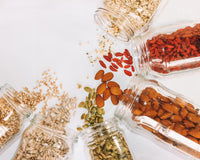Cooking is a creative, every day activity that can be a great way for you to unwind. It can be a prodigious source of finding your independence and imagination. It can be therapeutic and a lovely way to express yourself.
Cooking can also be incredibly inconvenient. When you have finished a busy day at work, or had a chaotic weekend, perhaps one of the last things you want to do, is cook a hearty meal from scratch.
In saying this, here are some hints and tips on some essential pantry staples to allow any, and every cooking journey in your kitchen to be convenient, stress free, and easy.
The history of canned foods
During the eighteen hundreds tin-coated canned products were introduced as an alternative to bottles. The multifunctional, robust cans were quickly a hit in the British Royal Navy, as the food supplied lasted many months and could be moved in great quantities. They also became popular in New York, USA to sell meats, fish and fruits in local markets. However, the trend didn’t pass on until the late eighteenth hundreds when Gail Bordon invented the highly acclaimed condensed milk.
During the second world war, home canning, and preserving food in jars became extremely popular. The concept became a patriotic idea through communities and was heavily suggested by the government for conserving food during rationing periods. The start of vegetables in cans only grew to more and more types of food.
Benefits of canned food
Through history, canned food was prevalent and although it is not talked about lots today, we can understand why it is a brilliant invention. Keeping pantry staples or essential staples at hand is highly convenient in meal prepping and unexpected cooking, as they are ready to use there and then.
Using organic canned goods is even better. Take organic canned vegetables for example. You know exactly where they have come from, you know they have less additives, unlike marketed large supermarket cans that have higher amounts of sugar and salt included. Organic tinned veggies are a healthier option packed full of nutrients, and the vegetables in jars are simply sitting there ready for you when you need them.
Tinned beans
Beans are a versatile ingredient, not only because they can be used in many meals, but because there are so many different types (black beans, baked beans, pinto beans, black-eyed peas, adzuki beans, cannellini beans, borlotti beans, fava beans, Edamame, chickpeas, great northern beans, cranberry beans, navy beans, kidney beans, lima beans, mung beans, soy beans) to choose from.
They are rich in protein and fibre; they have become common in vegetarian and vegan diets also, as they are a suitable and tasty protein substitute to meats and fish. Beans are nutritious and incredibly fulfilling when eating them. Some classic recipes including beans are- stews, casseroles, curries, soups, and chillis. These are great family recipes as they are bulky, simple, and can be batched cooked for further meals throughout the week.
Tinned pulses
On the other end of the bean spectrum are pulses. Pulses are the dried equivalent to tinned beans. Some examples of pulses are lentils, chickpeas, peas, and haricot beans. In cooking, pulses are easy to prepare as they don’t take long to cook. The versatile ingredient comes in different textures and tastes and can be used in hot meals such as stews, as well as cold meals like salads. They are easily digestible, so they are a safe option for anyone who suffers with any gastrointestinal issues.
Pulses include a high amount of soluble fibre which is great for helping to lower your cholesterol levels and protect your heart from any future issues. Alongside beans, pulses are rich in protein and are very satisfying in a meal. They contain heaps of vitamins and minerals that help keep your digestive system up to scratch.
Tinned tomatoes
Now, if you don’t already have some sort of tinned tomatoes in your kitchen or pantry, I urge you to get some immediately! Tinned tomatoes are the biggest staple ingredient. They are the base of so many recipes, that having them in your home will save you time and money. I promise you!
You can use tinned tomatoes in pastas, curries, chillis, pizzas, a bolognese, shakshuka’s, tomato soups, dahls, butter beans, basically any sauce you like. You can even have tomatoes on toast! Tomatoes have a great watery consistency and rich taste for sauces, which is why it is a great base for many recipes. It naturally thickens on its own, unlike many roux’s, so it is ideal for sauces on the go.
Alongside this, tomatoes are packed with antioxidants (lycopene), potassium, folate (vitamin B) and vitamin C. The fruit/vegetable boosts your immune system and helps with lowering inflammation in many parts of the body. Similar to many other plants, tomatoes contain phytonutrients which protect the food from threats such as small bugs, fungi, and basic germs.
However, there are many other options available to buy for recipes, if tinned tomatoes do not suit you personally.
Tomato Juice- With no seeds or skin included, it can be great for soups and cocktails.
Tomato Concentrate- A paste where the big amounts of tomato water are subtracted, so the tomato substance can be spread thickly or used in sauces for a full amount of flavour.
Tomato Passata- A thicker and larger amount of sauce derived from pureed tomatoes. It is predominantly used in sauces.
Jackfruit
Originating from the largest tree fruit globally, Jackfruit is a tropical fruit grown in South America, Asia and Africa. Jack fruit is related to the fig and mulberry family. Under the thick rind, the edible parts of a jack fruit are the yellow flesh and seeds. You can eat Jackfruit raw or cooked, it all depends on the cuisine.
Interestingly, the fruit can either have a sweet or savoury flavour, it all depends on how ripe it is. When unripe, Jackfruit is great in curries and stews. It is a great alternative for meat and fish, but it doesn’t contain as much protein as actual meat products. It is, however, still a countless substitute for pulled meat because it has a stringy texture, imitating barbeque meats such as pork or chicken. When buying savoury jackfruit, always look for labels with ‘unripe’ or ‘brine’ on it, so you know it is the right type.
When jackfruit is ripe, it is a great sweet snack on its own, or with sweet dishes. To name a few- Granola, smoothies, sorbet, yoghurt, cakes, and muffins. Sweet Jackfruit has a tropical taste, similar to mangos or pineapples. This comparable flavour should be helpful when looking for recipes to add the fruit to. Conveniently, Jackfruit is mostly sold as cut up chunks in cans and jars, or sold peeled and whole. Tinned jackfruit is another great ingredient to add to your pantry as it can be added to lots of dishes.
As for Jackfruits health benefits, one of its main profits is how low its sugar count is. The product has an overall low glycaemic index which means it can help lower cholesterol levels. This, on top of the inclusion of vitamin C, means it is great for people with (and to prevent people getting) diabetes type two. These nutrients help prevent inflammation, and oxidative stress levels.
Alike most fruits, it contains fibre and potassium, which works with the digestive system. Unusually, Jackfruit contains large amounts of potassium, which can be toxic for chronic kidney disease suffers.
Note: Anyone with kidney issues, birch pollen, or latex allergies should not intake the fruit as there have been studies with cross reactions.
Banana Blossom
With a clue in the name, the banana blossom is a flower that comes from the same tree as the banana fruit. This flower walks hand-in-hand with jackfruit as it has very similar benefits and uses. It is a great alternative for meat and fish, as it also has a stringy texture inside the flower (when cooked). The inside of the flower can be used in curries and stews as it is softer and chunkier.
The florets, on the other hand are harder and chewier, and tend to be used in salads, stir-fries, or even served with dips. The florets have been compared to the taste of an artichoke. The inside of the flower has a neutral flavour and can conveniently be seasoned to taste however you would like.
Both parts of the flower can be eaten raw, and can be found in many oriental shops, sold as tinned banana blossom or canned. Again, alike most fruits, it contains fibre and potassium, which works with the digestive system. The Banana blossom is rich in nutrients and minerals that work towards lowering blood sugar and cholesterol levels. It contains Vitamins A, C, and E, which support bone and joint health. The anti-inflammation properties help with and prevent further joint pain and promotes quicker healing.
Peppers
A versatile ingredient that comes in many different sizes, and spice levels are peppers. The colourful fruit/vegetable appears with plenty of nutritional value and can liven up most savoury dishes.
Bell Peppers
Also known as sweet peppers, bell peppers are a type of pepper with no spice. The fruit comes in the colours yellow, red, green, and orange. They can be eaten raw- a great packed lunch snack, nibbles with a dip, or a fresh crunch in a salad. They have a slight sweet flavouring, but are very low in calories, therefore, making them a great food for a balanced diet.
When cooking, tinned peppers are very adaptable. They can be steamed, fried, grilled, boiled and baked; you can even chuck them in the microwave or air fryer. Bell peppers texture changes when they are cooked, they slightly lose their crunch, but they are still packed with great flavour. Alike many other vegetables Peppers have quite a neutral flavour, so you can season them to your liking.
Chili Peppers
On the other side of the pepper family comes the spiced pepper. Chilis, though similar in texture have a different shape and size. Whilst bell peppers are wide and plumpy, chili peppers tend to be longer and thinner. (This is the easiest way to tell them apart before eating them) These pungent peppers are added to many dishes for their spice and heat additives. The products are particularly popular amongst countries such as India, Thailand, Bolivia, South America and even parts of Africa, where spice are used in everyday recipes.
All peppers combined have some great health benefits. Bell peppers are rich in lots of antioxidant vitamins, protecting you from future heart issues and accompanying your immune system whilst it fights off bacteria. Chili peppers have unique benefits that solely come from the spices. From improving the metabolism to helping promote red blood cell growth, chili peppers are a great ingredient to add to your pantry.






